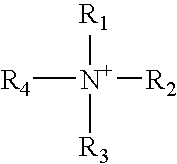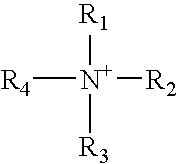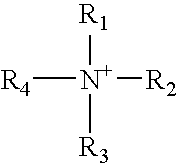Barrier polishing solution
- Summary
- Abstract
- Description
- Claims
- Application Information
AI Technical Summary
Benefits of technology
Problems solved by technology
Method used
Image
Examples
example 1
[0035] A list of solution compositions shown in Table 1 were prepared to evaluate the performance of two anti-yellowing additives (EDTA and citric acid) at varying concentration levels. In the preparation of the compositions-the requisite amounts of all required chemicals as shown in Table 1 (with the exception of the hydrogen peroxide and the abrasive) were added to deionized water in a container. The solution in the container is stirred until all the ingredients are dissolved in water. The abrasive was then added to the container. The pH of the solution was then adjusted to the target pH by the addition of nitric acid. Following this, the hydrogen peroxide was added to the container for use as a polishing composition.
[0036] The yellowing tests were conducted at room temperature without agitation. Slurries with different amounts of anti-yellowing additives were contained in plastic bottles. These bottles remained undisturbed in one location for up to 18 days. The color of these sl...
example 2
[0039] From example 1, slurries A, 2, 3 and 10 were selected for a polishing test to determine whether the presence of the additives affects wafer removal rates. In the test slurries, pH and concentration of H2O2 were slightly increased. Furthermore, EDTA in acidic form replaced the sodium salt of EDTA to reduce the total alkali ion concentration in the slurry. Similar to Example 1, slurries 12, 13 had the same effective molar concentrations of EDTA as slurries 2 and 3.
[0040] The polishing experiment was performed using a Mirra® model polishing tool manufactured by Applied Materials. The polishing pad was an IC1010™ porous polyurethane pad supplied by Rohm and Haas Electronic Materials CMP Technologies. The pad was conditioned prior to each run with a diamond abrasive plate manufactured by Kinik having 180 μm diamonds. The polishing process was performed at a membrane pressure of 10.33 kPa (1.5 psi), a table speed of 93 revolutions per minute (rpm) and a carrier speed of 87 rpm. Th...
example 3
[0042] This example examines the effect of the anti-yellowing additives on wafer defectivity.
[0043] The experiment was conducted on a Mirra® model polishing tool from Applied Materials. The polishing pad was an IC1010™ supplied by Rohm and Haas Electronic Materials CMP Technologies. The pad was conditioned prior to each run with a diamond abrasive plate manufactured by Kinik having 180 μm diamonds. The polishing process was performed at a pressure of 10.3 kPa (1.5 psi), a table speed of 93 revolutions per minute (rpm) and a carrier speed of 87 rpm. The CMP composition supply rate (slurry flow rate) was 200 milliliters / minute (ml / min). The 200 mm copper sheet wafers for the defectivity test were pre-polished by a commercially available slurry EPL2362 (manufactured by Eternal Chemical Co., Ltd.) for 1 minute using a CUP4410 pad (supplied by Rohm and Haas Electronic Materials CMP Technologies) and process parameters of 21.7 kPa (3 psi), 93 rpm table speed, 87 rpm carrier speed and 200...
PUM
| Property | Measurement | Unit |
|---|---|---|
| Fraction | aaaaa | aaaaa |
| Fraction | aaaaa | aaaaa |
| Fraction | aaaaa | aaaaa |
Abstract
Description
Claims
Application Information
 Login to View More
Login to View More - R&D
- Intellectual Property
- Life Sciences
- Materials
- Tech Scout
- Unparalleled Data Quality
- Higher Quality Content
- 60% Fewer Hallucinations
Browse by: Latest US Patents, China's latest patents, Technical Efficacy Thesaurus, Application Domain, Technology Topic, Popular Technical Reports.
© 2025 PatSnap. All rights reserved.Legal|Privacy policy|Modern Slavery Act Transparency Statement|Sitemap|About US| Contact US: help@patsnap.com



